The 27-inch Apple iMac Review (2011)
by Anand Lal Shimpi on May 27, 2011 2:30 AM ESTThe Display
Apple offers two display options with the iMac: a 1920 x 1080 21.5-inch panel and a 2560 x 1440 27-inch panel. I tested the latter for this review.
Right away I noticed a huge difference in the default settings for the 27-inch iMac vs. my 27-inch Cinema Display. The new iMac has a lower white point, I measured 6102K uncalibrated vs. 7133K on the 27-inch Cinema Display. Here's a quick pic showing you the difference side-by-side:
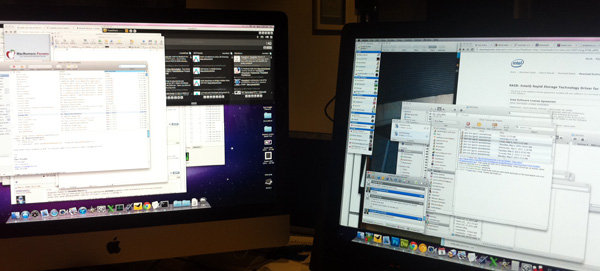
27-inch iMac (left) vs. 27-inch Cinema Display (right)
Obviously that's just a calibration issue, but it shows a little more foresight on Apple's part with the 27-inch iMac. Viewing angles seem the same between the two as well. There is a noticeable change in how Apple maps brightness levels to the software OSD on the iMac vs. the Cinema Display however. The iMac's controls are far more linear:
I'm not sure if Apple has made similar changes in currently shipping versions of the 27-inch Cinema Display but it makes a whole lot more sense now. Linear controls for non-linear curves are silly.
The change in default white point alone should be an indication that Apple is experimenting with panels or panel vendors, the rest of the data seems to back this up as well. Maximum brightness is down a bit and but so are black levels, which means overall contrast ratio remains unchanged.

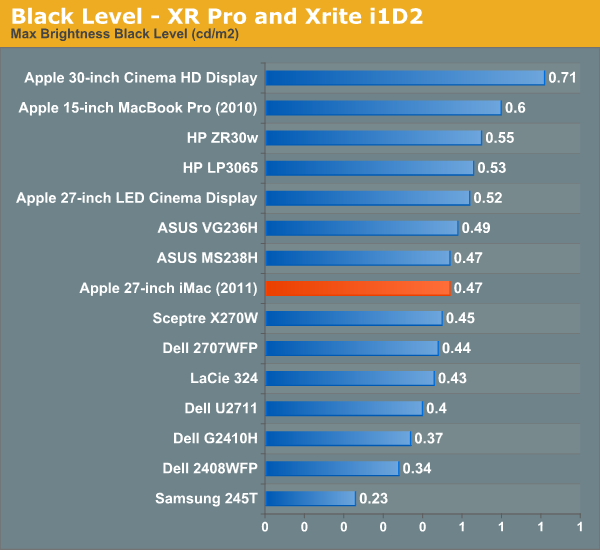
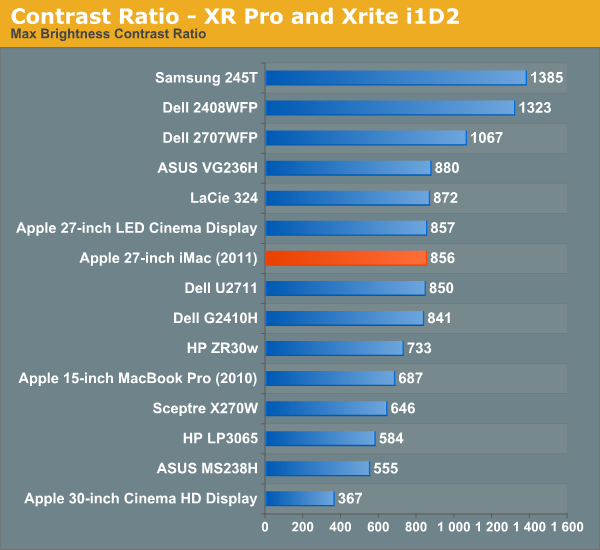
The new panel seems less uniform than the old one but it's not something that's noticeable in regular use, only if you actually measure the white/black levels on the panel.
Where the 2011 iMac does a lot better than my Cinema Display is in its color reproduction. The overall delta-E of the new panel is measurably lower than what was used in the first run of 27-inch Cinema Displays (and presumably last year's iMac):
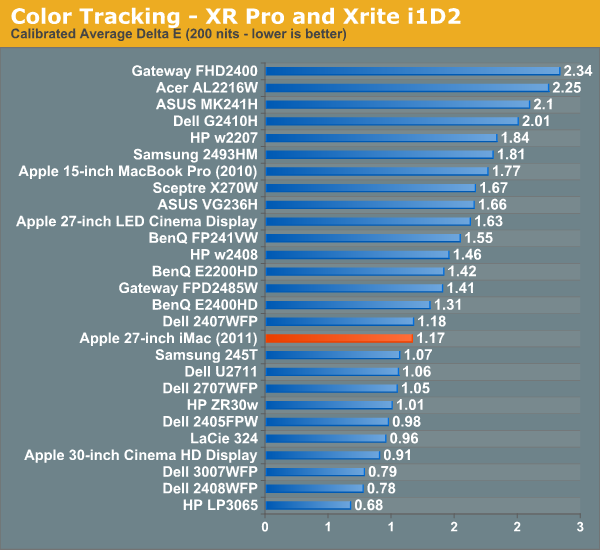
I will say that despite what you see here numerically, you'd be hard pressed to tell a difference between the two panels as long as they're both calibrated.
Color gamut is a bit worse on the new panel vs. the old one from what I can tell. Both are WLED backlit which limits the spectrum of colors they can accurately reproduce.
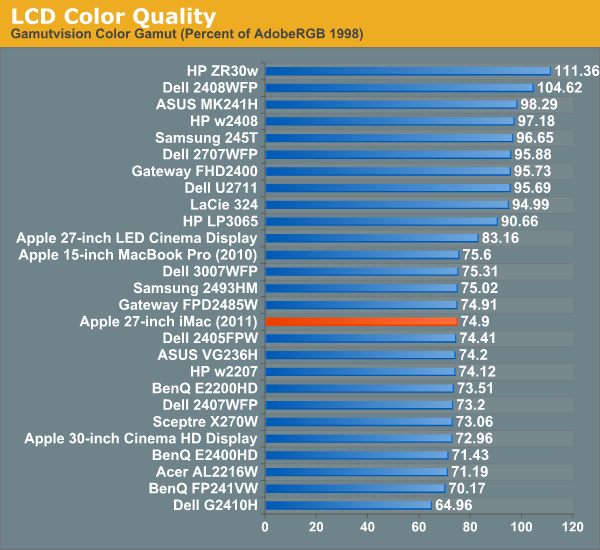
Overall I'm just as much a fan of the 27-inch iMac display as I was of the 27-inch Cinema Display. The iMac is obviously bulkier but overall desk footprint is similar and you get a Sandy Bridge system as a part of the deal.












139 Comments
View All Comments
tipoo - Friday, May 27, 2011 - link
Nevermind me, it was answered in the article.tipoo - Friday, May 27, 2011 - link
I heard that unlike previous iMacs, the new ones can only use another mac with Thunderbolt to use the iMac as a targeted display. Is that true? I wouldn't feel so bad about discarding such a system when the GPU and CPU feel too old in two or three years like Anand mentioned if I could use it as an external display, but I think the new ones are limited to only being used by other Macs. And that's also assuming Mac's in 3 years will use compatible Thunderbolt ports.TegiriNenashi - Friday, May 27, 2011 - link
What is wrong with this display? Just one number: 16:9.QuietOC - Friday, May 27, 2011 - link
I have used a 20" white iMac and 24" aluminum iMac. The later has a big persistent image problem. Evidently IPS pixels don't work well in a hot environment. The low noise level of the iMac is nice to mostly not hear, but the visual noise might be worse.Also the cheap 320GB WD Caviar failed by randomly disappearing which may have be heat related, and the USB ports have also started randomly disconnecting. The mouse and keyboard just stop working during the day and I have to unplug them and plug them back in. So, no, I would not recommend getting a $1000 monitor with a computer mounted inside it.
KoolAidMan1 - Friday, May 27, 2011 - link
I've owned both the 24" iMac you talk about and a 27" from late 2009. Image persistence became a problem with the 24" models, as well as the CCFL losing some of its brightness by the two year mark.The new 27" models do not have either issue. Image persistence has been fixed, and I don't expect there to be any fading since LED backlights don't suffer from the same degredation issues that CCFL backlit displays do over time. On a related note, I have a NEC 2490WUXi as my secondary display. That monitor uses the same 24" H-IPS panel that the old 24" iMac did. It has minor image retention issues, but not to the same degree as the iMac had. Whatever LG did with their new 27" panels seems to have addressed that problem.
zhill - Friday, May 27, 2011 - link
First off, nice article Anand. Well presented and I think your perspective is a common one in this case. I agree that the lack of upgrade options and rather mediocre gpu performance are certainly off-putting for a machine in this price range, but I also think that your observation that if you are willing to spend $1800 for a laptop with a reasonably short lifecycle then the iMac is not much different. I think you've really hit the point there--the iMac's target customer.I would argue that most iMac users are not highly technical, power users. They are people that want a big screen and don't need the portability of a laptop. These people, like my parents, value the simplicity and ease of use of the iMac and the fact that their workspace is often small and would rather it not be covered in cords and cables. In that case not only does the iMac make sense but it's lifespan is substantially longer and all the GPU they need is enough to drive the system and maybe do some video editing. Gaming prowess has never been an apple concern and I doubt it will be until Steve Jobs decides to buy Activision or EA. I do like the iMac from a compute appliance perspective, just plug it in and compute--no fuss. Also, trying to make a reasonable gaming rig with a 2560x1440 display is a fairly daunting task even with today's cards. You would have to be near the top-end and that's a whole lot of power and heat to dissipate in a reasonably small enclosure (considering the size of a 6970 or 580 card by itself).
I also have to say that Intel's recent willingness to keep switching chip sockets has made upgrades far more painful than they should be (yes, I have a core i7-920 with socket 1366 that is now essentially orphaned).
Alberts - Friday, May 27, 2011 - link
Securedoc for Mac from a company called Winmagic supports SSD's with encryption hardware as long they adhire to the opal specification from the trusted computing groupJimmiG - Friday, May 27, 2011 - link
You can't upgrade the hardware and you can't separate the computer from the display so you can keep using the display long after the hardware has become obsolete.That's pretty much the oposite of "green".
Spazweasel - Friday, May 27, 2011 - link
This may be old news (I'm not going to wade through 6 pages of Apple-hating trolls to see), but you CAN use your 27" iMac as a monitor:http://support.apple.com/kb/HT3924
It's called "Target Display Mode".
KoolAidMan1 - Friday, May 27, 2011 - link
Note that it is only talking about the 2009 and 2010 models with mini-DP ports. Those can take an external source so you can use the 27" iMac as a monitor. I use it every day as the primary monitor for my gaming PC.The new 2011 iMacs have different requirements since they switched to Thunderbolt ports. Until an adapter or something comes out, the only sources that can output a video signal to the 2011 iMacs are Thunderbolt equipped computers. For the time being this only limits them to 2011 Macbook Pros and other iMacs (which would be a weird application).
I love the iMacs, but as someone who uses Target Display Mode every day, the new requirements bother me. It won't be a problem in a year or so when Thunderbolt becomes more common, but for the time being it is pretty limiting.